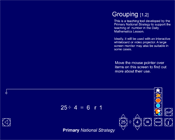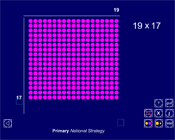Consolidation and practice
These resources are to support children in guided or independent work. Roll over the highlighted resources for a description.
Multiplication facts

This interactive teaching program (ITP) is an ICT-based tool to support the exploration of multiplication and division. Multiplication facts ITP allows the child or teacher to represent multiplication facts as a rectangular array and as steps on a number line.
Grouping

This interactive teaching program (ITP) is an ICT-based tool to support the exploration of division. Grouping ITP allows the child or teacher to model division as grouping and to link this process to jumps on a number line. It can also be used to introduce children to remainders and to apply their knowledge through setting similar problems that can be solved using the image displayed.
Multiplication array

This interactive teaching program (ITP) is an ICT-based tool to support the exploration of multiplication. Multiplication array ITP allows the child or teacher to uncover a section of an array of counters, dropping on grid lines to explore methods of multiplication.
Opportunities to use and apply
Possible contexts include:
- practical resources that involve arrays, e.g. How many eggs does an egg box hold?

- practical contexts that involve grouping, e.g. There are 29 children here today. How many teams of four can we make?
- word problems, including those that involve money and measures, e.g. How many 5p coins make 45p? How much lemonade is needed to fill four 300-ml cups?
Confirming learning
Ask probing questions such as:
- Which of these statements is true?
5 × 3 = 3 + 3 + 3
5 × 3 = 5 + 5 + 5
5 × 3 = 5 + 5 + 5 + 5 + 5
- 24 pencils are shared equally into pots with none left over. How many pots could there be and how many pencils would be in each pot?
- Ross saves 20p a day for a week. How much money has he saved at the end of the week?
- How many fives make 40? Make up a problem that involves solving this calculation.
- A gardener plants three rows of cabbages. Each row contains eight cabbages. How many cabbages are there altogether?
- How many pairs can be made from 26 socks? How do you know?

 Knowing and using number facts
Knowing and using number facts



